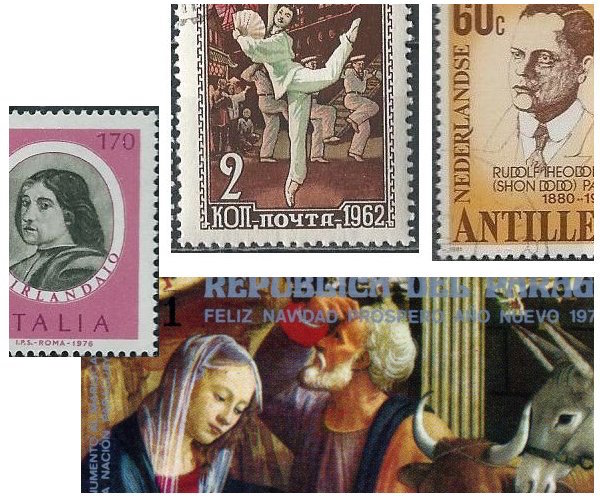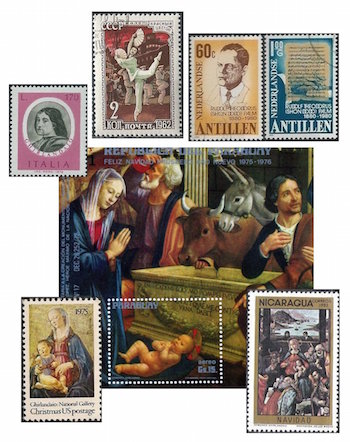The Arts on the Stamps of the World — January 11
An Arts Fuse regular feature: the arts on stamps of the world.

By Doug Briscoe
There is apparently no stamp for the Norwegian composer Christian Sinding, who was born on this day in 1856 (d. 3 December 1941). Norway has issued stamps for Grieg, of course, for Ole Bull, and for Johan Svendsen, but Sinding has none. Apparently no 19th-century Norwegian composer was more sinned against than Sinding.
The father of Reinhold Glière (11 January 1875 [O.S. December 30 1874] – 23 June 1956) was an instrument maker from Saxony who had emigrated to Kiev with his Polish wife. There young Reinhold was born. He studied violin with Otakar Ševčík (look for his stamp in March) before moving on to the Moscow Conservatory where his teachers were the all-star team of Taneyev (counterpoint), Ippolitov-Ivanov (composition), and Arensky and Conus (harmony). His graduation piece was an opera after Byron (whose birthday is the 22nd inst.) that took the conservatory’s gold medal in composition. It was around this time (c1900) that the young composer changed the spelling and pronunciation of his name from Glier (GLEER) to Glière (glee-YAIR), which has led everybody to assume he was of French or Belgian ancestry. When he himself took up teaching, his first private students were Miaskovsky and Prokofiev, who was only 11 years old at the time. When Glière went to Berlin to study conducting with Oskar Fried, one of his fellow students was Serge Koussevitzky, who led the première of Glière’s Second Symphony in the German capital in 1908. Back in Russia (first Kiev, then Moscow), Glière’s roster of many distinguished pupils included Lyatoshynsky (his stamp was shown here just last week—January 3rd), Vladimir Dukelsky (Vernon Duke), Khachaturian, and Mosolov (composer of the notorious orchestral work Iron Foundry). Glière’s most famous score, the ballet The Red Poppy, whose most famous number is the Russian Sailor’s Dance, was composed in 1927. While the composer himself has no commemorative stamp, the ballet was featured in a series honoring the Russian Ballet issued in 1961-62. With his devotion to a predominantly Romantic musical idiom, he escaped the artistic purges of 1936 and 1948.

Curaçaoan composer Rudolf Palm (11 January 1880 – 11 September 1950) played multiple instruments: piano, organ, saxophone, clarinet, and flute. He played organ over the period 1902 to 1950 at several different locations for different faiths: two Jewish synagogues, a Protestant church, and a Masonic Lodge! In addition he was for some time a flutist with the Curaçao Philharmonic. Rudolf Palm founded two ensembles of his own, “Los Dispuestos” of about twenty players, and a sextet, called simply “Los seis”. His compositional output consists of about ninety piano pieces, most of them dances, and songs.
Italian Renaissance painter Domenico Ghirlandaio may have died on this date in 1494. Born in Florence at some point in 1449 with the unwieldy moniker of Domenico di Tommaso di Currado di Doffo Bigordi, he was the eldest child of a dealer in textiles and a goldsmith. (“Ghirlandaio” is Italian for “garland-maker.”) Domenico’s natural gift for drawing was noticed and developed through apprenticeships, and most of his subsequent work was devoted to frescoes. The centerpiece of our Ghirlandaio display is a complete souvenir sheet from Paraguay showing the artist’s altarpiece Nativity and Adoration of the Shepherds from the Sassetti Chapel (1485). At the upper left corner we see an Italian issue from 1976, one of an extended series celebrating famous Italian artists. At the bottom corners are two Ghirlandaio Christmas stamps. As with the Giotto and Sirani stamps we saw three days ago, a Ghirlandaio Madonna (c1470-75) was chosen by the US Postal Service for one of their annual Christmas designs, this one for the season of 1975; and the other example is a Nicaraguan issue from 1983 reproducing his Adoration of the Magi (1488).
Though he has no stamp I’m aware of, I thought we should mention South African writer of Cry the Beloved Country Alan Paton (11 January 1903 – 12 April 1988).
A graduate of the University of Massachusetts with a B.A. in English, Doug Briscoe worked in Boston classical music radio, at WCRB, WGBH, and WBUR, for about 25 years, beginning in 1977. He has the curious distinction of having succeeded Robert J. Lurtsema twice, first as host of WGBH’s weekday morning classical music program in 1993, then as host of the weekend program when Robert J.’s health failed in 2000. Doug also wrote liner notes for several of the late Gunther Schuller’s GM Recordings releases as well as program notes for the Boston Classical Orchestra. For the past few years he’s been posting a Facebook “blog” of classical music on stamps of the world, which has now been expanded to encompass all the arts for The Arts Fuse.
